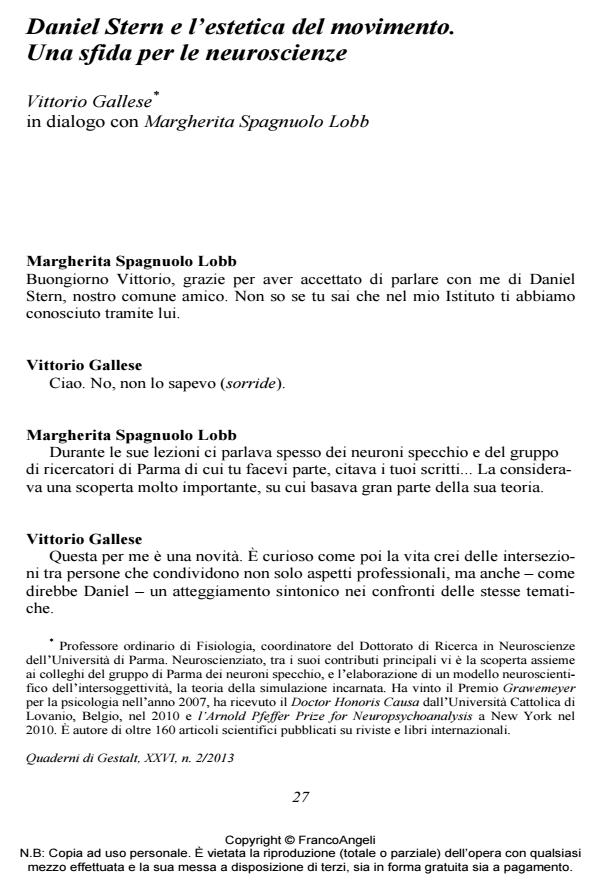Daniel Stern and the aesthetic of movement. A challenge for neuroscience
Journal title QUADERNI DI GESTALT
Author/s Vittorio Gallese, Margherita Spagnuolo Lobb
Publishing Year 2014 Issue 2013/2
Language Italian Pages 14 P. 27-40 File size 805 KB
DOI 10.3280/GEST2013-002005
DOI is like a bar code for intellectual property: to have more infomation
click here
Below, you can see the article first page
If you want to buy this article in PDF format, you can do it, following the instructions to buy download credits

FrancoAngeli is member of Publishers International Linking Association, Inc (PILA), a not-for-profit association which run the CrossRef service enabling links to and from online scholarly content.
In this exciting dynamic of questions and answers, the two authors remember experiences shared with Daniel Stern with some depth and insight about important topics for psychotherapy and neuroscientific research: co-created intersubjectivity, embodied simulation, brain/body process, evidence derived from child observation, implicit relational knowledge, experiences of time and movement, and phenomenology. Both authors are grateful for the theoretical opening and the theoretical and empirical strength of Daniel Stern’s research, his reflections that they consider "ahead of their time", and his courage to enact a dialogue of psychodynamic perspective with a cognitive, physiological and philosophical dimension of experience.
Keywords: Daniel Stern, intersubjectivity, embodied knowledge, phenomenology, neurosciences, movement.
- Damasio A. (1995). L’errore di Cartesio. Emozione, ragione e cervello umano. Milano: Adelphi. Di Cesare G., Di Dio C., Rochat M.J., Sinigaglia C., Bruschweiler-Stern N., Stern D.N., Rizzolatti
- G. (2013). The neural correlates of “vitality form” recognition: an fMRI study. Social Cognitive and Affective Neuroscience. DOI: 10.1093/scan/nst06
- Gallese V. (2006). Intentional attunement: A neurophysiological perspective on social cognition and its disruption in autism. Brain Research, 1079, 1: 15-24.
- Gallese V., Migone P., Eagle M.N.(2006). La simulazione incarnata: i neuroni specchio, le basi neurofisiologiche dell’intersoggettività e alcune implicazioni per la psicoanalisi. Psicoterapia e Scienze Umane, XL, 3: 543-580.
- Meltzoff A.N., Moore M.K. (1977). Imitation of facial and manual gestures by human neonates. Science, 198, 4312: 75-78.
- Panksepp, J., Biven L. (2010). The Archaeology of Mind: Neuroevolutionary Origins of Human Emotion. New York: W. W. Norton & Company.
- Perls F., Hefferline R., Goodman P. (1994, ed. or. 1951). Gestalt Therapy: Excitement and Growth in the Human Personality, New York: The Gestalt Journal Press (trad. it.: Terapia e pratica della terapia della Gestalt. Vitalità e accrescimento della personalità umana, Roma: Astrolabio, 1971; 1997).
- Rochat M.J, Veroni V., Bruschweiler-Stern N., Pieraccini C., Bonnet-Brilhault F., Barthélémy C., Malvy J., Sinigaglia C., Stern D.N., Rizzolatti G. (2013). Impaired vitality form recognition in autism. Neuropsychologia, 51, 10: 1918-1924. DOI: 10.1016/j.neuropsychologia.2013.06.00
- Solms, M., Turnbull O. (2002). The Brain and the Inner World: An Introduction to the Neuroscience of Subjective Experience. New York: Other Press.
- Spagnuolo Lobb M. (2011). Il now-for-next in psicoterapia. La psicoterapia della Gestalt raccontata nella società post-moderna. Milano: FrancoAngeli. Stern D.N. (1985). The interpersonal world of the infant: A view from psychoanalysis and developmental psychology. New York: Basic Books (trad. it.: Il mondo interpersonale del bambino. Torino: Bollati Boringhieri, 1987).
- Stern D.N. (2004). The present moment in Psychotherapy and Everyday Life. New York: Norton (trad. it.: Il momento presente in psicoterapia e nella vita quotidiana. Milano: Raffaello Cortina, 2005).
- Stern D.N. (2010). Forms of Vitality. Exploring Dynamic Experience in Psychology and the Arts. USA: Oxford University Press.
- Micro e macro cambiamento nel processo psicoterapico: un tentativo di ricerca Mauro Ambrosini, Marina Bertoni, Alice Faccini, Daniela Maggioni, Paolo Vassallo, in SETTING 48/2024 pp.77
DOI: 10.3280/SET2024-048003
Vittorio Gallese, Margherita Spagnuolo Lobb, Daniel Stern e l’estetica del movimento. Una sfida per le neuroscienze in "QUADERNI DI GESTALT" 2/2013, pp 27-40, DOI: 10.3280/GEST2013-002005